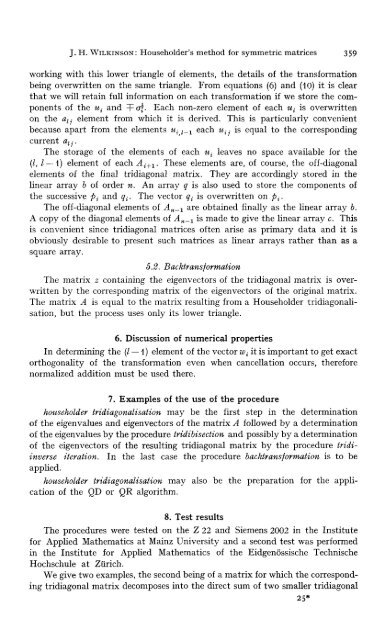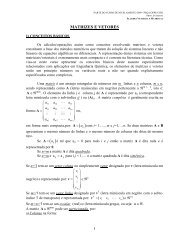Householder's method for symmetric matrices
Householder's method for symmetric matrices
Householder's method for symmetric matrices
Create successful ePaper yourself
Turn your PDF publications into a flip-book with our unique Google optimized e-Paper software.
J. H. WILKINSON: <strong>Householder's</strong> <strong>method</strong> <strong>for</strong> <strong>symmetric</strong> <strong>matrices</strong> 359<br />
working with this lower triangle of elements, the details of the trans<strong>for</strong>mation<br />
being overwritten on the same triangle. From equations (6) and (10) it is clear<br />
that we will retain full in<strong>for</strong>mation on each trans<strong>for</strong>mation if we store the com-<br />
ponents of the u i and :J: a, ~. Each non-zero element of each u i is overwritten<br />
on the ali element from which it is derived. This is particularly convenient<br />
because apart from the elements ui, l_ 1 each uii is equal to the corresponding<br />
current a~i.<br />
The storage of the elements of each u i leaves no space available <strong>for</strong> the<br />
(1, l--t) element of each Ai+ 1. These elements are, of course, the off-diagonal<br />
elements of the final tridiagonal matrix. They are accordingly stored in the<br />
linear array b of order n. An array q is also used to store the components of<br />
the successive Pi and qi- The vector qi is overwritten on Pi-<br />
The off-diagonal elements of A~_I are obtained finally as the linear array b.<br />
A copy of the diagonal elements of A~_ 1 is made to give the linear array c. This<br />
is convenient since tridiagonal <strong>matrices</strong> often arise as primary data and it is<br />
obviously desirable to present such <strong>matrices</strong> as linear arrays rather than as a<br />
square array.<br />
5.2. Backtrans/ormation<br />
The matrix z containing the eigenvectors of the tridiagonal matrix is over-<br />
written by the corresponding matrix of the eigenvectors of the original matrix.<br />
The matrix A is equal to the matrix resulting from a Householder tridiagonali-<br />
sation, but the process uses only its lower triangle.<br />
6. Discussion of numerical properties<br />
In determining the (1 -- t) element of the vector w i it is important to get exact<br />
orthogonality of the trans<strong>for</strong>mation even when cancellation occurs, there<strong>for</strong>e<br />
normalized addition must be used there.<br />
7. Examples of the use of the procedure<br />
householder tridiagonalisation may be the first step in the determination<br />
of the eigenvalues and eigenvectors of the matrix A followed by a determination<br />
of the eigenvalues by the procedure tridibisection and possibly by a determination<br />
of the eigenvectors of the resulting tridiagonal matrix by the procedure tridi-<br />
inverse iteration. In the last case the procedure backtrans/ormation is to be<br />
applied.<br />
householder tridiagonalisation may also be the preparation <strong>for</strong> the appli-<br />
cation of the QD or QR algorithm.<br />
8. Test results<br />
The procedures were tested on the Z 22 and Siemens 2002 in the Institute<br />
<strong>for</strong> Applied Mathematics at Mainz University and a second test was per<strong>for</strong>med<br />
in the Institute <strong>for</strong> Applied Mathematics of the EidgenSssische Technische<br />
Hochschule at Zfirich.<br />
We give two examples, the second being of a matrix <strong>for</strong> which the correspond-<br />
ing tridiagonal matrix decomposes into the direct sum of two smaller tridiagonal<br />
25*






